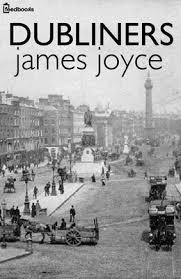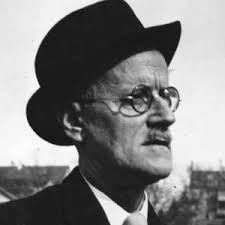Book Review of James Joyce’s The Dubliners
12/7/14 — REREADING JAMES JOYCE’S THE DUBLINERS
This is the time of year for reconnecting with family and friends, a time to renew bonds and remember what makes a relationship special. So, too, with good books. I often find that the holidays are the perfect time to reread the classics, those priceless novels that offer something new, no matter how many times you read them.
 That’s why I was so pleased when my book club chose to read and discuss The Dubliners, James Joyce’s first (and probably most accessible) work of prose. Published in 1914, this slim volume of 15 short stories presents a stark, penetrating analysis of middle-class life in Dublin in the early 20th century, a time when poverty was rampant, the influence of church was strong, and nationalism was at its peak.
That’s why I was so pleased when my book club chose to read and discuss The Dubliners, James Joyce’s first (and probably most accessible) work of prose. Published in 1914, this slim volume of 15 short stories presents a stark, penetrating analysis of middle-class life in Dublin in the early 20th century, a time when poverty was rampant, the influence of church was strong, and nationalism was at its peak.
The stories in The Dubliners are linked in theme and style and purpose. Though many have been published as stand-alone stories, they were always intended to work together. “My intention was to write a chapter of the moral history of my country and I chose Dublin for the scene because that city seemed to me to represent the centre of paralysis,” Joyce wrote later.
The stories are arranged chronologically in the sense that they move from childhood to adolescence to adulthood, examining small but significant moments: A young boy ponders the death of a priest who befriended him, an adolescent boy strives to impress a beautiful girl only to have his hopes dashed by an inconsiderate uncle, a girl tries to muster the courage to leave home but finds she just can’t do it, a mother meddles in her daughter’s affairs to the detriment of both their reputations, and a married couple fails to connect despite their genuine love for each other.
When my book club got together to discuss The Dubliners, I was quite surprised to find that many of the members were disappointed. They complained that the characters were too similar, the stories lacked action, and some had no plot at all. Much of that is true, but for me that was the beauty of the work. The stories are all slice-of-life adventures that don’t have a clear beginning, middle, and end, just as most of the chapters in our lives lack such obvious benchmarks. When one reader suggested an unknown author submitting this collection to agents and publishers today would get roundly rejected, I couldn’t help but agree—and shed a tear for what that says about the current state of publishing.
 Instead of action-filled plots, Joyce was more concerned with epiphanies—a word he defined as a moment where a character experiences self-understanding or illumination. These moments seem to fascinate Joyce not because they lead to major character changes, but because they usually don’t. Consider “A Painful Case,” perhaps, the most poignant of the stories. It concerns a meticulous introvert, Mr. Duffy, whose life is perfectly ordered in meaningless routines. Against all odds, he forms a wonderful friendship with Mrs. Sinico, which he brutally ends after she lifts his hand to touch her cheek, the first sign of physical intimacy. Four years later, he learns of her suicide, and realizes the damage he’s done to both her and himself by his refusal to grasp what life has to offer. And yet despite this epiphany, he quickly returns to the same isolated routine that characterized his life before the friendship.
Instead of action-filled plots, Joyce was more concerned with epiphanies—a word he defined as a moment where a character experiences self-understanding or illumination. These moments seem to fascinate Joyce not because they lead to major character changes, but because they usually don’t. Consider “A Painful Case,” perhaps, the most poignant of the stories. It concerns a meticulous introvert, Mr. Duffy, whose life is perfectly ordered in meaningless routines. Against all odds, he forms a wonderful friendship with Mrs. Sinico, which he brutally ends after she lifts his hand to touch her cheek, the first sign of physical intimacy. Four years later, he learns of her suicide, and realizes the damage he’s done to both her and himself by his refusal to grasp what life has to offer. And yet despite this epiphany, he quickly returns to the same isolated routine that characterized his life before the friendship.
Much has been written about “The Dead,” the masterpiece that concludes The Dubliners. Suffice it to say here that the “The Dead” encapsulates the themes developed in the stories that precede it, exploring the intersection of life and death and the personal paralysis that prevents individuals from embracing life. The concluding scene, as beautiful and poetic as any in literature, ends with a poignant ambiguity, as snow blankets the city in what could be viewed as a symbol of either a shroud of death or a universal cleansing.
Critics have noted that The Dubliners lacks much of the complexity of Joyce’s later work. To a large extent, what you see is what you get. And that is still another beauty of the work. The language is superb, with stark images that bring dark and dreary Dublin to life—or show its lack of life as the case may be. Joyce’s images are detailed and precise, with a quiet, unsentimental beauty. They speak for themselves, often to show the disappointment and despair of the people who inhabit the novel. The result is a powerful work, one that I know I’ll want to return to again in some future holiday season.
Mark Willen
Mark Willen’s novels, Hawke’s Point, Hawke’s Return, and Hawke’s Discovery, were released by Pen-L Publishing. His short stories have appeared in Corner Club Press, The Rusty Nail. and The Boiler Review. Mark is currently working on his second novel, a thriller set in a fictional town in central Maryland. Mark also writes a blog on practical, everyday ethics, Talking Ethics.com.
- Web |
- More Posts(48)